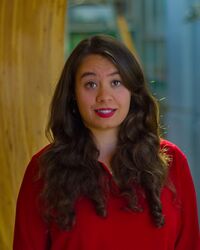CAZypedia celebrates the life of Senior Curator Emeritus Harry Gilbert, a true giant in the field, who passed away in September 2025.
CAZypedia needs your help!
We have many unassigned pages in need of Authors and Responsible Curators. See a page that's out-of-date and just needs a touch-up? - You are also welcome to become a CAZypedian. Here's how.
Scientists at all career stages, including students, are welcome to contribute.
Learn more about CAZypedia's misson here and in this article. Totally new to the CAZy classification? Read this first.
Difference between revisions of "User:Maria Cleveland"
| Line 1: | Line 1: | ||
[[Image:Maria_2018.jpg|200px|right]] | [[Image:Maria_2018.jpg|200px|right]] | ||
| − | Maria Cleveland obtained her B.Sc. in Biology in 2014 from Queen’s University in Ontario, Canada. She had worked in the laboratories of Dr. Stan Brown, Dr. Laurent Seroude and Dr. David Zechel studying palladium based metallocycle catalysts, genetics of fruit flies and secondary metabolites of ''Streptomyces curacoi'', respectively. The in 2015, she moved to British Columbia where she pursued her PhD in Chemistry under the supervision of Dr. Harry Brumer at the University of British Columbia in the Michael Smith Laboratories. The work focused on recombinant production, biochemical characterization and product analysis of fungal Auxiliary Activity enzymes, specifically [[AA5]]_2 <cite>Cleveland2021a Cleveland2021b</cite>. | + | Maria Cleveland obtained her B.Sc. in Biology in 2014 from Queen’s University in Ontario, Canada. She had worked in the laboratories of Dr. Stan Brown, Dr. Laurent Seroude and Dr. David Zechel studying palladium based metallocycle catalysts, genetics of fruit flies and secondary metabolites of ''Streptomyces curacoi'', respectively. The in 2015, she moved to British Columbia where she pursued her PhD in Chemistry under the supervision of Dr. Harry Brumer at the University of British Columbia in the Michael Smith Laboratories. The work focused on recombinant production, biochemical characterization and product analysis of fungal Auxiliary Activity enzymes, specifically [[AA5]]_2 <cite>Cleveland2021a Cleveland2021b</cite>. Her work has showcased the wide range of substrate specificities that exist in this subfamily and demonstrated that the catalytic flexibility of the AA5_2 could be potentially used in a variety of biotech applications. |
| − | |||
| − | |||
| − | |||
<biblio> | <biblio> | ||
#Cleveland2021a pmid=34134727 | #Cleveland2021a pmid=34134727 | ||
Revision as of 09:57, 26 November 2021
Maria Cleveland obtained her B.Sc. in Biology in 2014 from Queen’s University in Ontario, Canada. She had worked in the laboratories of Dr. Stan Brown, Dr. Laurent Seroude and Dr. David Zechel studying palladium based metallocycle catalysts, genetics of fruit flies and secondary metabolites of Streptomyces curacoi, respectively. The in 2015, she moved to British Columbia where she pursued her PhD in Chemistry under the supervision of Dr. Harry Brumer at the University of British Columbia in the Michael Smith Laboratories. The work focused on recombinant production, biochemical characterization and product analysis of fungal Auxiliary Activity enzymes, specifically AA5_2 [1, 2]. Her work has showcased the wide range of substrate specificities that exist in this subfamily and demonstrated that the catalytic flexibility of the AA5_2 could be potentially used in a variety of biotech applications.
- Cleveland M, Lafond M, Xia FR, Chung R, Mulyk P, Hein JE, and Brumer H. (2021). Two Fusarium copper radical oxidases with high activity on aryl alcohols. Biotechnol Biofuels. 2021;14(1):138. DOI:10.1186/s13068-021-01984-0 |
- Cleveland ME, Mathieu Y, Ribeaucourt D, Haon M, Mulyk P, Hein JE, Lafond M, Berrin JG, and Brumer H. (2021). A survey of substrate specificity among Auxiliary Activity Family 5 copper radical oxidases. Cell Mol Life Sci. 2021;78(24):8187-8208. DOI:10.1007/s00018-021-03981-w |
- Gilbert HJ, Stålbrand H, and Brumer H. (2008). How the walls come crumbling down: recent structural biochemistry of plant polysaccharide degradation. Curr Opin Plant Biol. 2008;11(3):338-48. DOI:10.1016/j.pbi.2008.03.004 |
